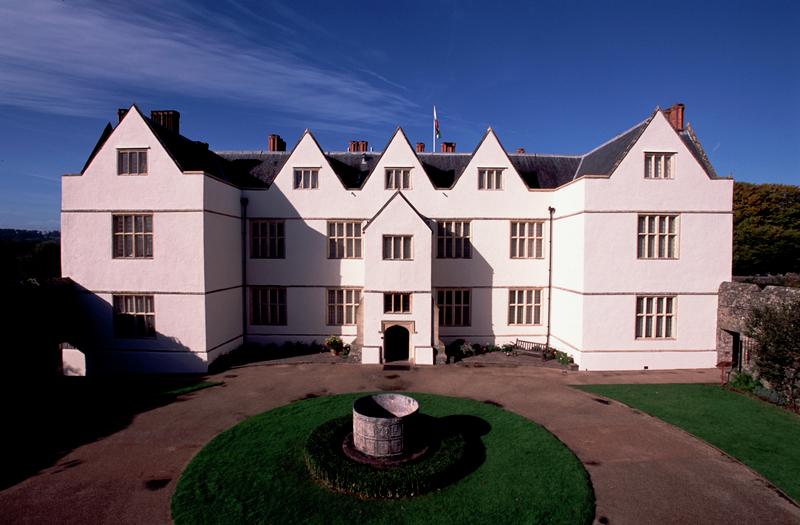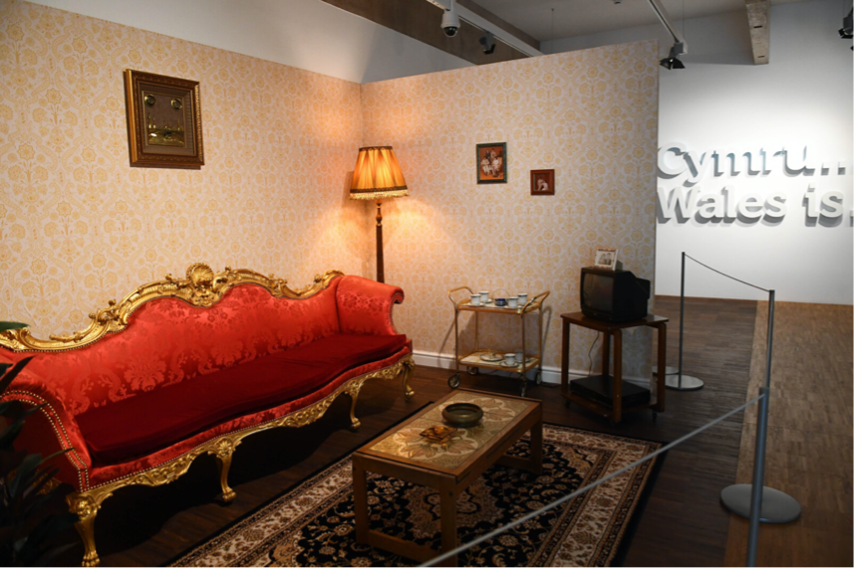Last year Amgueddfa Cymru and Arts Council Wales launched Perspective(s), a two-year programme which seeks to bring about a change in the heritage sector by commissioning work that reflects Wales’s cultural and ethnic diversity and brings marginalised voices, experiences and histories to the foreground. Each of Amgueddfa Cymru’s seven museums was matched with a visual arts organisation, who in turn engaged a creative professional from a culturally and ethnically diverse background to create new work and displays in response to the specific site and its collections.
St Fagans National Museum of History in Cardiff was matched with Ways of Working, an artist-led social enterprise working with agendas of social, environmental, racial and community justice, who engaged Nasia Sarwar-Skuse as lead artist. Nasia is an editor, writer, artist and creative facilitator who focuses on colonisation of India/Pakistan, migration and decolonisation in her creative practice. In recent months, Nasia and Ways of Working have developed a series of creative interventions in prominent positions around the museum which highlight objects in the collection with colonial connections and amplify marginalised voices. An interactive installation in the museum’s atrium poses questions around the themes of colonialism, power and museums to visitors, such as ‘The British empire was...?’ and ‘What is the museum’s job within society?’, inviting responses on post-it notes; not only is this a dynamic installation, with a new question each month and new responses being added by the hour, but its location means that visitors are presented with the question on their way in, putting it at the forefront of their mind while they explore the museum.
Three of Nasia’s installations have highlighted the connection between St Fagans and the Clive family, in particular Robert Clive (1725-1774), known as ‘Clive of India’, a coloniser who expanded the British Empire across South Asia, looting and making himself a multimillionaire in the process. Though St Fagans National Museum of History is perhaps best known as an open-air museum filled with re-erected buildings, at the heart of the museum is St Fagans Castle, an Elizabethan manor house built on the site of a medieval castle, which was donated to the National Museum of Wales in 1946 and in whose grounds the open-air museum was established. Though St Fagans Castle was built by a local man, by 1736 it has come into the possession of the English Windsor family, the Earls of Plymouth. The union between the Windsor and aforementioned Clive family was formed on the marriage of Harriet Windsor (1797-1869), younger sister of the 6th Earl of Plymouth, to Robert Henry Clive (1789-1854), grandson of ‘Clive of India’, in 1819. Both Harriet and Robert inherited their respective families estates, thus the Windsor and Clive estates were merged, and in 1855 they obtained a royal licence to adopt the double-barrel surname ‘Windsor-Clive’. This was a mutually beneficial union - the Windsor family were a noble old family of Saxon origin who had been elevated to the aristocracy by William the Conqueror, and their pedigree helped legitimise the Clive family’s claim to gentility. On the other hand, the Clive family brought their colonial fortune and perceived military prestige, which successive generations of the Windsor-Clive family continued to emphasise; a monograph published on the coming-of-age of Robert George Windsor-Clive (1857-1923) reminded tenants that ‘to Robert Clive – to his boldness in council and daring in war – Great Britain is indebted in a great measure for the creation and establishment of her Indian Empire’. The family connection with the British Empire continued, for the heir to the estate Other Windsor-Clive (1884-1908) served as aide-de-camp to Earl Minto, Viceroy of India, and died of typhoid fever in Agra in 1908.

Nasia has drawn visitors' attention to the Clive family’s colonial history in an installation in the ‘Wales is...’ gallery. Here she has created a living room from her memories of growing up in a South Asian household in northern England in the late-1970s and early 1980s, filled with her own family photographs. For many South Asian diaspora families, the living room represented a safe, homely space in an often hostile, new environment. But at the centre of this familiar, domestic scene is an eighteenth-century giltwood sofa which formed part of a nineteen-piece suite that ‘Clive of India’ had commissioned for his London townhouse in Berkeley Square in 1766. Purchased by the National Museum of Wales in 1958, the sofa has sat in the Impressionist Gallery at National Museum Cardiff rather inconspicuously for half a century. It was moved to St Fagans especially for Nasia’s installation, where it sits as the centrepiece and where the gaze is finally turned on the coloniser. Nasia has also hosted a series of conversations with critical friends of the project in this space.

At other Clive properties such as Powis Castle, now under the care of the National Trust, the family’s colonial connections are manifest in the interior decoration and contents of the house. Powis Castle holds over a thousand South Asian artefacts looted or acquired by ‘Clive of India’, his son Edward Clive, 1st Earl of Powis (1754-1839), and daughter-in-law Henrietta Herbert (1758-1830), constituting the largest private collection of this type in the United Kingdom. Since 1987 these have been displayed in the dedicated ‘Clive Museum’ in the old Billiards Room. At St Fagans Castle the Clive legacy is somewhat less conspicuous, to the extent that many visitors are completely unaware of the colonial connections. Nasia has addressed this by placing a striking installation in the most public room in the house, the Hall. This is a re-creation of mobile palace made of painted chintz which belonged to Tipu Sultan (1750-1799), ruler of the Kingdom of Mysore and commonly referred to as the ‘Tiger of Mysore’, which was looted by Edward Clive and subsequently brought to Powis Castle, where it was used as a marquee for garden parties. Nasia recounts her impressions on her first encounter with the tent at the ‘Clive Museum’ in her Queen Mary Wasafiri New Writing Prize-winning piece ‘Absent Presence’. The recreated tent in St Fagans Castle also incorporates written extracts from Tipu Sultan’s dream journal, creating a dialogue across centuries between him and Nasia.
If the tent could speak, it might tell the names of the artisans who spread out the fabric and carried out mathematical equations to ensure the canopy was cut accurately. It may recall the hands holding threaded needles as they stitched the black and white rosette band that runs along the along the top of its qanat section. Or explain the meaning of the scripts in faint black stamps on its red cotton. Would it divulge the dreams that Tipu recorded in his journal each day whilst ensconced in its lavish floral interior, lying on luxurious sheets of silk? It may tell of its journey across the sea and how, for many years as a final insult to rub salt on colonial wounds, it was made to serve as a marquee for garden parties. But for now, it lies shrouded.
The Clive colonial fortune became embedded in the Windsor-Clive estate, funding building and landscaping work at St Fagans Castle in the mid-Victorian period. As part of the Perspective(s) project and in anticipation of the opening of Nasia’s installations, I was invited to give a talk to museum staff on exactly which parts of the house and gardens were created with this fortune. This period saw interventions to the rear of the house, namely a new servants’ block to bring the servants’ accommodation at St Fagans Castle up to Victorian standards after a long period of absenteeism and the transformation of a ten-metre scarp above the fishponds into a series of formal terraces. Both of these additions were detailed in a watercolour proposal of circa 1855 by Robert Windsor-Clive (1824-1859), great-grandson of ‘Clive of India’. Though Robert Clive died in 1859, his mother Harriet and widow Mary endeavoured to realise his proposals over the next decade. Both the servants’ block and the terraces were executed in a Gothic style, exaggerating the amount of medieval fabric which survived on the site and making the house appear more castle-like, perhaps in an attempt to assert the Windsor-Clive family’s position and remind their tenants of their pedigree and links to the Middle Ages. The servants’ block was built in 1867-69 in the Scots Baronial style with a conical turret; the way it was integrated with the medieval curtain wall made it appear fortress-like and much taller than it was in reality. The terraces, built in 1864-71, were also Gothic in character, with a Watch Tower, battlements, a wall-walk, and muscular buttresses. Architecturally, these additions have been so successfully integrated with the rest of the house and gardens that the source of the money used to create them has historically been overlooked.
Visitors to the museum may have noticed the carved, stone balustrades woven throughout the terraces and crowning the roof of the Watch Tower and the turret of the servants’ block. What at first glance appears to be an ornamental feature, with alternating cross and star motifs, in fact has a much more significant meaning. With the crosslets representing the Windsor family and the five-pointed star representing the Clive family, these ‘Windsor-Clive balustrades’ represent the union of two families, literally setting it in stone. They are reminiscent of Elizabethan and Jacobean parapet inscriptions, such as those at Hardwick Hall which displayed Bess of Hardwick’s initials across the skyline. ‘Clive of India’ adopted the five-pointed star as well as elephants on his coat-of-arms to represent his links to India, and later the five-pointed star became known as the ‘Star of India’ and was used on flags during the period of British Raj in the Indian subcontinent. Without a doubt, the balustrades are the most conspicuous physical manifestation of the Clive connection and the colonial connection at St Fagans Castle, yet this connection is ‘hidden in plain sight’. There is a poignancy to Nasia’s fourth installation, a site-specific film called ‘Absent Presence’ playing in the Dining Room of St Fagans Castle featuring Sanea Singh, born and raised in India, dancing on the terraces and in front of the Windsor-Clive balustrades, claiming the space as her own.
I extend my warmest congratulations to Nasia and Ways of Working for creating such powerful work which has brought St Fagans Castle’s colonial connections to the attention of visitors to the museum. Moreover, the work centres South Asian heritage and voices which have long been associated with St Fagans Castle, but which have been silenced until now. I’d urge everyone to visit St Fagans National Museum of History to see these installations and to see St Fagans Castle in a new light.
(Authored by Bethan Scorey, with thanks to Nasia Sarwar-Skuse and Ways of Working for their permission. Image credit: Wales News Service / Amgueddfa Cymru.)
